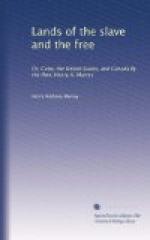Let us now turn from that which carries our bodies at the rate of forty miles an hour, to that last giant stride of science by which our words are carried quick as thought itself—the Telegraph. The Americans soon discovered that this invention was calculated to be peculiarly useful to them, owing to their enormous extent of territory; and having come to this conclusion, their energy soon stretched the electric messenger throughout the length and breadth of the land, and by the last Census the telegraphic lines extend 16,735 miles, and the length of wires employed amounts to 23,281. The Seventh Census gives the expense of construction as 30l. per mile.[BH] The systems in use are Morse’s, House’s, and Bain’s; the two former of American invention, the latter imported from this country. Of these three the system most generally employed is Morse’s, the others being only worked upon about 2000 miles each. It would be out of place to enter into any scientific explanation of their different methods in these pages; suffice it to say, that all three record their messages on ribands of paper; Morse employing a kind of short-hand symbol which indents the paper; Bain, a set of symbols which by chemical agency discolour the paper instead of indenting it; and House printing Roman letters in full by the discolouring process. Those who wish for details and explanations, will find them in the works of Dr. Lardner and others on the Telegraph.
The following anecdote will give some idea of the rapidity with which they work. A house in New York expected a synopsis of commercial news by the steamer from Liverpool. A swift boat was sent down to wait for the steamer at the quarantine ground. Immediately the steamer arrived, the synopsis was thrown into the boat, and away she went as fast as oars and sails could carry her to New York. The news was immediately telegraphed to New Orleans and its receipt acknowledged back in three hours and five minutes, and before the steamer that brought it was lashed alongside her wharf. The distance to New Orleans by telegraph is about 2000 miles. The most extensive purchases are frequently made at a thousand miles distance by the medium of the telegraph. Some brokers in Wall-street average from six to ten messages per day throughout the year. I remember hearing of a young officer, at Niagara Falls, who, finding himself low in the purse, telegraphed to New York for credit, and before he had finished his breakfast the money was brought to him. Cypher is very generally used for two reasons; first, to obtain the secrecy which is frequently essential to commercial affairs; and secondly, that by well-organized cypher a few words are sufficient to convey a long sentence.




